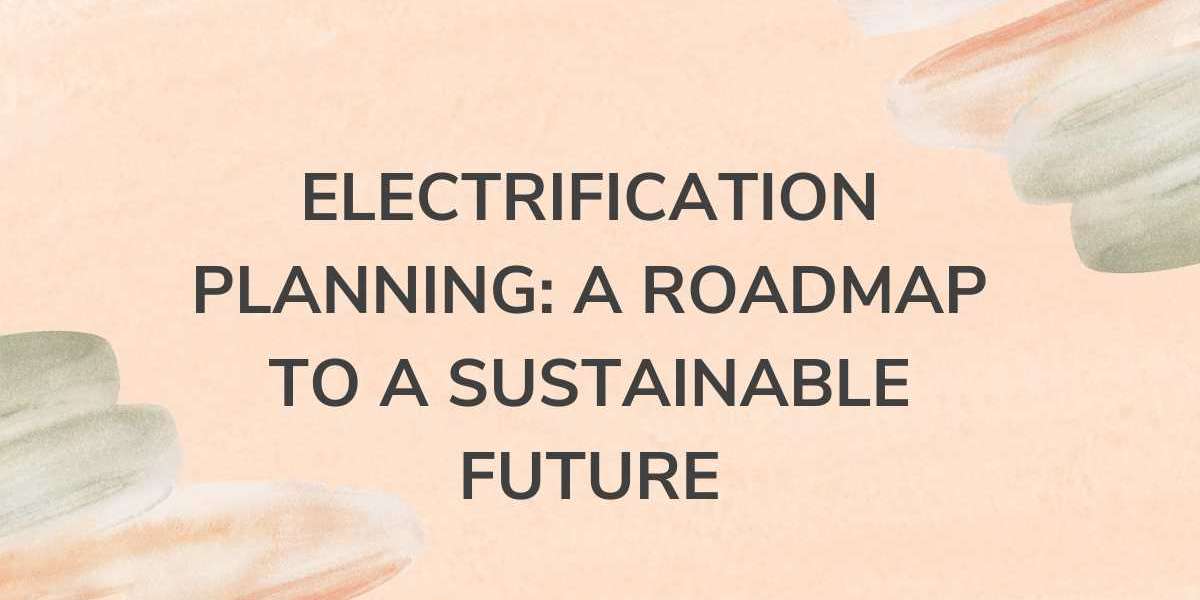Electrification Planning: A Roadmap to a Sustainable Future
Introduction
As the world moves toward a carbon-neutral future, electrification planning has become a key strategy for reducing reliance on fossil fuels and transitioning to cleaner energy sources. From transportation and industrial sectors to residential and commercial buildings, the shift toward electric-powered systems is transforming global economies and infrastructure.
Electrification planning involves developing and implementing strategies to replace fossil fuel-based energy systems with electric alternatives, improving energy efficiency, reducing greenhouse gas emissions, and enhancing sustainability. This blog explores the importance of electrification planning, key sectors undergoing electrification, technological advancements, challenges, and FAQs related to the topic.
What is Electrification Planning?
Electrification planning is the process of systematically transitioning transportation, industries, homes, and businesses from traditional energy sources (coal, oil, gas) to clean electricity. It involves:
- Infrastructure development: Expanding power grids, charging stations, and renewable energy capacity.
- Technology integration: Adoption of electric vehicles, heat pumps, and smart grids.
- Policy and regulations: Government incentives, carbon reduction goals, and energy efficiency mandates.
- Investment in renewables: Supporting wind, solar, and hydroelectric energy for clean power generation.
By replacing fossil fuel-dependent systems with efficient, electric-powered solutions, electrification planning contributes to a sustainable, cost-effective, and reliable energy future.
Key Sectors Undergoing Electrification
1. Transportation Electrification
The transportation sector is one of the largest contributors to carbon emissions, making its electrification crucial for sustainability.
Electric Vehicles (EVs)
- EV adoption is increasing globally, with manufacturers like Tesla, Ford, and Volkswagen leading the market.
- Charging infrastructure is expanding with ultra-fast chargers and wireless charging technology.
- Vehicle-to-grid (V2G) technology allows EVs to supply power back to the grid during peak demand.
Public Transport Fleets
- Cities worldwide are replacing diesel-powered buses with electric buses to improve air quality.
- Companies like Amazon and UPS are deploying electric delivery vans to reduce fleet emissions.
- Electric trains, ferries, and autonomous vehicles are being developed to further advance e-mobility.
2. Industrial Electrification
Industries traditionally rely on coal, natural gas, and diesel for energy-intensive processes. Electrification solutions include:
- Electric boilers furnaces: Replacing gas-based heating systems with electric-powered alternatives.
- Battery storage systems: Enhancing grid reliability for industrial facilities.
- Hydrogen fuel electrification: Industries are shifting towards green hydrogen produced using renewable electricity.
3. Residential Commercial Building Electrification
Buildings account for a significant portion of global energy use. Electrification planning focuses on:
- Heat pumps replacing gas-powered heating and cooling systems.
- Smart grids energy-efficient appliances reducing overall power consumption.
- Solar panel battery storage systems for self-sufficient homes and businesses.
4. Renewable Energy Power Grid Upgrades
- Renewable integration: Expanding wind, solar, and hydroelectric energy capacity to support electrification.
- Grid modernization: Smart grids and AI-powered energy management enhance grid stability.
- Decentralized energy production: Consumers producing and storing their own electricity contribute to energy independence.
Technological Advancements in Electrification Planning
1. Smart Grid Technology
Smart grids optimize electricity distribution, reduce energy waste, and improve reliability through:
- AI-driven demand response systems that adjust electricity supply based on usage.
- Decentralized energy management, allowing homes and businesses to generate and sell excess power.
- Real-time monitoring, reducing power outages and inefficiencies.
2. Advanced Battery Storage Solutions
- Solid-state batteries promise higher energy density and faster charging for electric vehicles and grid storage.
- Lithium-ion battery recycling is advancing to reduce environmental impact.
- Second-life batteries repurpose EV batteries for renewable energy storage.
3. Wireless Ultra-Fast Charging Infrastructure
- Wireless charging roads are being tested in Sweden and Germany, allowing EVs to charge while driving.
- Ultra-fast 350 kW chargers cut charging times to under 20 minutes, making EVs more convenient.
- Bidirectional charging enables EVs to act as power sources for homes and businesses.
4. Hydrogen Fuel Cell Technology
- Hydrogen fuel cells are emerging as an alternative for long-haul transportation and heavy industries.
- Green hydrogen is produced using renewable electricity, making it a cleaner energy option.
Challenges in Electrification Planning
1. Infrastructure Development
- Expanding charging networks and grid upgrades require significant investments.
- Many regions still lack sufficient renewable energy capacity to support full electrification.
2. High Initial Costs
- EVs, heat pumps, and battery storage systems are still more expensive than traditional alternatives.
- Governments and businesses must invest in subsidies and incentives to drive adoption.
3. Grid Stability Energy Demand
- A high demand for electricity could strain existing grids if not managed efficiently.
- Smart grid technologies and energy storage solutions are necessary to ensure reliability.
4. Battery Production Recycling
- Mining for lithium, cobalt, and nickel has environmental and ethical concerns.
- Battery recycling technologies must advance to create a sustainable supply chain.
The Future of Electrification Planning
The transition to an all-electric future is inevitable, with several innovations shaping the electrification landscape:
- Fully autonomous electric vehicles powered by AI-driven energy management.
- Next-gen battery technology enabling longer-lasting, ultra-fast charging storage solutions.
- Smart cities utilizing real-time energy monitoring to optimize electricity use.
- Decentralized energy production, where homes and businesses produce, store, and share electricity efficiently.
By prioritizing electrification planning, businesses, governments, and individuals can contribute to a sustainable, energy-efficient future.
Frequently Asked Questions (FAQs)
1. What is electrification planning?
Electrification planning is the process of transitioning transportation, industries, buildings, and infrastructure from fossil fuels to electric-powered solutions for sustainability and energy efficiency.
2. Why is electrification important?
Electrification helps reduce carbon emissions, improves energy efficiency, lowers long-term costs, and enhances air quality.
3. How does transportation electrification work?
Transportation electrification involves replacing gasoline and diesel-powered vehicles with electric alternatives, supported by charging networks and battery advancements.
4. What challenges does electrification face?
Key challenges include high initial costs, charging infrastructure expansion, grid stability, and battery recycling issues.
5. What are the benefits of building electrification?
Buildings using electric heating, cooling, and appliances consume less energy, reduce carbon footprints, and support renewable energy integration.
6. Can electrification work in all climates?
Yes, but cold weather can reduce battery efficiency, requiring advanced thermal management systems in EVs and heating solutions.
7. How does renewable energy impact electrification?
Renewables like solar, wind, and hydro provide clean electricity to power EVs, homes, and industries, reducing dependence on fossil fuels.
8. What is smart grid technology?
Smart grids use AI and real-time data to optimize electricity distribution, improve efficiency, and prevent power outages.
9. What role does hydrogen play in electrification?
Hydrogen fuel cells provide an alternative to batteries for long-haul transport and heavy industries, offering clean energy solutions.
10. What’s the future of electrification?
The future includes AI-powered smart cities, next-gen battery storage, autonomous electric fleets, and decentralized renewable energy production.
Conclusion
Electrification planning is crucial for a sustainable future, reducing reliance on fossil fuels and enhancing energy efficiency. With advancements in EVs, smart grids, and battery storage, the world is moving toward a cleaner, more reliable energy system. By investing in electrification solutions, governments, businesses, and individuals can create a carbon-neutral world.
? The future is electric—are you ready to embrace it?







